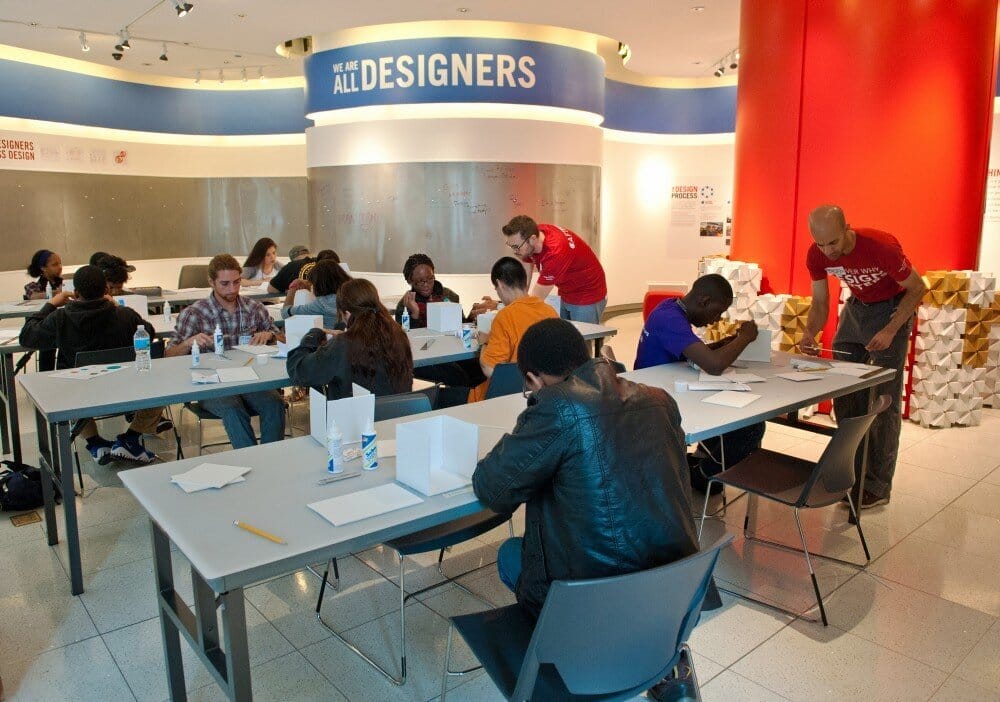
Design thinking and CAC
Your new running shoes. The latest app for your phone. The giant new highway interchange. You may never have stopped to consider it, but all these objects were created utilizing a process called "design thinking."
Your new running shoes. The latest app for your phone. The giant new highway interchange. You may never have stopped to consider it, but all these objects were created utilizing a process called "design thinking."
by Jen Masengarb, Director of Interpretation and Research
WHAT IS DESIGN THINKING?
For several centuries, architects have been trained to think and develop solutions using the design process steps. Scientists, engineers and product designers also use similar steps of inquiry when solving problems. And in the last 10 years, especially, other fields such as business and K-12 education have also increasingly utilized design thinking.
Different fields may visualize and name the steps of the process in various ways, but they all share a common thread of being process-oriented, instead of simply being driven by the creation of a product. This means that designers are constantly asking “what if” and trying to truly understand the problem at hand—and the people they are designing for—without quickly rushing to find a solution.
If you’ve ever tackled a really big problem and designed a solution for it, there’s a good chance you utilized some of the five steps in the design process:
- Identify the problem and understand the people you’re designing for
- Collect information on the problem and learn how others may have solved something similar
- Brainstorm and analyze your ideas
- Develop a solution that you could test out and get feedback on
- Improve your original idea
A DESIGN THINKING MINDSET AT CAC
At CAC, our programs for youth embody the idea that “We are all designers,” a statement that is displayed prominently on the wall of our ArcelorMittal Design Studio. Our activities that serve young children through high school teenagers are built on the belief that youth are inherently curious and creative. They want to solve problems rather than replicate what already exists. CAC programs, curricula, workshops and digital tools are built around the design process.
The most public design thinking tool from CAC is DiscoverDesign.org—originally developed and launched in 2012 and then redesigned (after going through a rigorous design process!) in 2016. This award-winning digital platform is filled with real-world design challenges that connect teens, educators and mentors across the country. Students learn and use the steps of the design process, develop a portfolio, earn badges and work alone or as part of a class, all while getting feedback from a national network of peers and design professionals.
CAC uses the design process in a variety of hands-on and in-person programs as well. At this year’s iteration of our annual Engineering Fest, middle school students designed, built and tested movable bridges. Our new Design Your Neighborhood workshop asks teens to identify and collect information on what makes a good neighborhood. In this year’s Newhouse Architecture and Design Competition, hundreds of teens are designing parks, micro-apartment furniture, murals, school additions and graphic identity signage for neighborhoods, giving them a chance to learn to think like a designer.
Even in a recent Read and Build program for our youngest audiences, 3 to 5-year-olds used design thinking. After reading the Three Little Pigs together, they studied and tested various building materials—soft, hard, strong, colorful—then made choices on what to use for their new home design. Even at this young age, the preschoolers are capable of making decisions, explaining their thinking to the group, testing theories on what will work best, getting feedback and learning from mistakes in order to improve on the next iteration.
Learning as a young designer often can be a confusing journey of not knowing what questions to ask next. Jenni Groot Mushynski, CAC’s curriculum and community development manager, explains, “When students are frustrated, when they’re overwhelmed or wanting to give up that’s when the design process really becomes useful.”
CAC’s education facilitators help guide this process—getting young designers to ask additional questions, talk about what they learned, reconsider solutions that aren’t working and make new decisions.
INTERESTED IN LEARNING MORE?
In addition to exploring CAC’s tools and programs, several great online resources are available for learning more and utilizing design thinking in your classroom or workplace. The names of the design process steps may differ between organizations and fields, but they all share a similar methodology: creative and critical thinking in an iterative process.
Edutopia: Well-respected for educational innovation, Edutopia regularly explores design thinking and how these concepts translate to the K-12 classroom.
IDEO: Developed by IDEO, a global design company, this toolkit helps educators get started in using design thinking in their classroom.
Stanford’s d.school: The university’s deep dive into the steps of the design process. Their virtual crash course also includes video resources.
Design Thinking for Museums: Educator and design thinking facilitator Dana Mitroff Silvers’ blog explores how museums and other non-profits are using human-centered design thinking.
Design for America:: The DFA guide outlines how to apply the skills and values of human-centered design to address social challenges.
